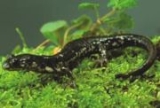
Wehrle's Salamander
Encyclopedia
Wehrle's salamander is a large salamander
with webbed hind feet. It is named in honor of R.W. Wehrle. The species was the first described from one of his many collections.
, where it hides by day beneath stones or rocks. It is also found at the entrances of caves and deep rock crevices, as well as burrows under rocks and logs.
Salamander
Salamander is a common name of approximately 500 species of amphibians. They are typically characterized by a superficially lizard-like appearance, with their slender bodies, short noses, and long tails. All known fossils and extinct species fall under the order Caudata, while sometimes the extant...
with webbed hind feet. It is named in honor of R.W. Wehrle. The species was the first described from one of his many collections.
Description
It is bluish-black with big, scattered white spots on its back. Its sides are covered with white to yellow spots and blotches. Its belly and the ventral surface of the tail are solid gray, and the throat and upper chest usually have white or yellowish blotches. The species grows to a length of 10–17 cm (4-6⅝ inches).Reproduction
Mating occurs from fall through spring. A large cluster of eggs is laid in early summer in damp logs, soils or moss, and in crevices in caves. Reproduction is biennial or irregular, with many mature females failing to breed each year.Behavior and Habitat
This species stays under cover during the day, and comes out to forage at night. This species is found on forested hillsides in the Appalachian PlateauAppalachian Plateau
The Appalachian Plateau is the western part of the Appalachian mountains, stretching from New York and Alabama. The plateau is a second level United States physiographic region....
, where it hides by day beneath stones or rocks. It is also found at the entrances of caves and deep rock crevices, as well as burrows under rocks and logs.

